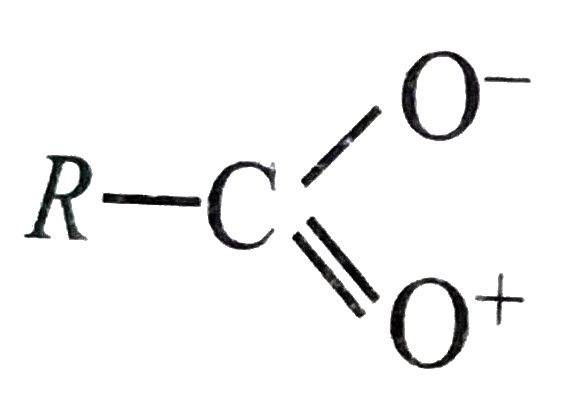Although phenoxide ion has more number of resonating structures than carboxylate ion, carboxylic acid is a stronger than phenol. Why ?
To understand why carboxylic acids are stronger than phenols, despite phenoxide ions having more resonating structures than carboxylate ions, we can analyze the stability of the respective ions formed from these compounds.
1. Understanding Acidity:
- The strength of an acid is determined by its ability to donate a proton (H⁺) and the stability of the resulting conjugate base after deprotonation.
2. Formation of Conjugate Bases:
- When phenol (C₆H₅OH) donates a proton, it forms the phenoxide ion (C₆H₅O⁻).
- When a carboxylic acid (RCOOH) donates a proton, it forms the carboxylate ion (RCOO⁻).
3. Resonance Structures:
- The phenoxide ion has several resonance structures, which helps to delocalize the negative charge over the aromatic ring. However, this negative charge is localized on a single oxygen atom.
- The carboxylate ion has two resonance structures where the negative charge is delocalized between two electronegative oxygen atoms. This means that the negative charge is more effectively stabilized.
4. Electronegativity and Charge Distribution:
- In the carboxylate ion, the negative charge is shared between two oxygen atoms, both of which are highly electronegative. This leads to greater stability of the carboxylate ion compared to the phenoxide ion, where the negative charge is localized on one oxygen atom.
5. Conclusion on Acidity:
- Since the carboxylate ion is more stable than the phenoxide ion due to better charge distribution and resonance stabilization, carboxylic acids are stronger acids than phenols. The greater stability of the conjugate base (carboxylate ion) compared to that of the phenoxide ion leads to a stronger acidic nature of carboxylic acids.
Summary:
Carboxylic acids are stronger than phenols because the carboxylate ion formed after deprotonation is more stable than the phenoxide ion due to better resonance stabilization and charge distribution over two electronegative oxygen atoms.
- The strength of an acid is determined by its ability to donate a proton (H⁺) and the stability of the resulting conjugate base after deprotonation.
- When phenol (C₆H₅OH) donates a proton, it forms the phenoxide ion (C₆H₅O⁻).
- When a carboxylic acid (RCOOH) donates a proton, it forms the carboxylate ion (RCOO⁻).
- The phenoxide ion has several resonance structures, which helps to delocalize the negative charge over the aromatic ring. However, this negative charge is localized on a single oxygen atom.
- The carboxylate ion has two resonance structures where the negative charge is delocalized between two electronegative oxygen atoms. This means that the negative charge is more effectively stabilized.
- In the carboxylate ion, the negative charge is shared between two oxygen atoms, both of which are highly electronegative. This leads to greater stability of the carboxylate ion compared to the phenoxide ion, where the negative charge is localized on one oxygen atom.
- Since the carboxylate ion is more stable than the phenoxide ion due to better charge distribution and resonance stabilization, carboxylic acids are stronger acids than phenols. The greater stability of the conjugate base (carboxylate ion) compared to that of the phenoxide ion leads to a stronger acidic nature of carboxylic acids.
Carboxylic acids are stronger than phenols because the carboxylate ion formed after deprotonation is more stable than the phenoxide ion due to better resonance stabilization and charge distribution over two electronegative oxygen atoms.
Topper's Solved these Questions
- ALIPHATIC AND AROMATIC ALDEHYDES AND KETONESBOOK - CENGAGE CHEMISTRY ENGLISHCHAPTER - ALIPHATIC AND AROMATIC ALDEHYDES AND KETONESEXERCISE - Exercises Linked Comprehension
59 Videos
- ALIPHATIC AND AROMATIC ALDEHYDES AND KETONESBOOK - CENGAGE CHEMISTRY ENGLISHCHAPTER - ALIPHATIC AND AROMATIC ALDEHYDES AND KETONESEXERCISE - Exercises Multiple Correct
33 Videos
- ALIPHATIC AND AROMATIC ALDEHYDES AND KETONESBOOK - CENGAGE CHEMISTRY ENGLISHCHAPTER - ALIPHATIC AND AROMATIC ALDEHYDES AND KETONESEXERCISE - Exercises Subjective
52 Videos
- ALCOHOL,PHENOL AND ETHERSBOOK - CENGAGE CHEMISTRY ENGLISHCHAPTER - ALCOHOL,PHENOL AND ETHERSEXERCISE - Archives Analytical And Descriptive
15 Videos
- APPENDIX INORGANIC VOLUME 2BOOK - CENGAGE CHEMISTRY ENGLISHCHAPTER - APPENDIX INORGANIC VOLUME 2EXERCISE - Short Answer Type
179 Videos
Similar Questions
Knowledge Check
The correct structure representation of carboxylate ion is
A B
B C
C D
D
Why ethanoic acid is a stronger acid than ethanol.
View SolutionWhy ethanoic acid is a stronger acid than ethanol.
View SolutionWhat makes acetic acid a stronger acid than phenol?
View SolutionWhat makes acetic acid a stronger acid than phenol?
View SolutionWhat makes acetic acid a stronger acid than phenol?
View SolutionWhy oxalic acid is a stronger acid than acetic acid?
View SolutionWhy sulphuric acid is stronger than sulphurous acid?
View Solution
